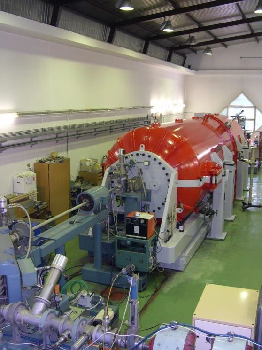Time-of-flight Elastic Recoil Detection Analysis (ToF-ERDA)
Ruđer Bošković Institute in Zagreb

Elastic Recoil Detection Analysis (ERDA), also referred to as forward recoil scattering (or, contextually, spectrometry), is an ion beam analysis technique in materials science to obtain elemental concentration depth profiles in thin films. In the technique of ERDA, an energetic ion beam is directed at a sample to be characterized and (as in Rutherford backscattering) there is an elastic nuclear interaction between the ions of the beam and the atoms of the target sample. Such interactions are commonly of a Coulomb nature. Depending on the kinetics of the ions, cross section area and the loss of energy of the ions in the matter, ERDA helps determine the quantification of the elemental analysis. It also provides information about the depth profile of the sample. The unique characteristic of this technique is the element depth profiling of a wide range of elements, from hydrogen to rare earth elements with similar sensitivity and depth resolution. Concentrations of 0.1 atomic percent can easily be detected.
In comparison to conventional ERDA with a stopping foil, in ToF-ERDA all elements (including hydrogen isotopes) are separated and analyzed in a single measurement.
Contact: Zdravko Siketic
Technical specifications
The instrument uses heavy ion (such as Cl, I, Au) beams with energies of 0.5 MeV/A to recoil atomic nuclei from the target surface layers in a forward direction. Energy and time of flight of the recoiled nuclei are measured in coincidence, enabling separation of all elements by energy and mass. Time/energy spectra are converted to depth profiles using the known relationship of energy loss by unit of length of the ions in the sample (stopping power). Because of the high stopping power of heavy ions, depth resolution down to the nm range at the surface can be achieved for C, N and O. Mass resolution of the TOF-ERDA system is 1 amu up to mass of 50 amu.
Sample requirements
Samples are exposed to the beam under the grazing angle and therefore only those with a flat surface can be reliably analyzed. Sample size is limited to 10×10 mm2. Up to 5 samples can be simultaneously installed through the load lock system into the analysis chamber. Single element spectra are extracted from the 2D multi-elemental spectrum, while elemental depth profiles are evaluated using the CORTEO software.
Detailed information can be found on the instrument’s webpage.



